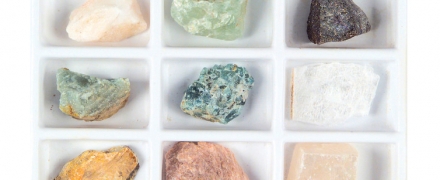open 10 am - 7 pm
laboratory is closed
Mohs scale and stone hardness

Hardness for each of the minerals is one of the main physical properties. It is determined by the degree of resistance to mechanical action of more solid bodies and is mainly due to the strength of the crystal lattice and its mechanical parameters. Hardness can be affected by the type of structure of the mineral, the chemical bond between atoms and molecules and its strength, particle sizes and charges, and other crystallochemical factors.
In mineralogy, there is a relative hardness scale created back in the 19th century. Frederick Moos. It is a set of 10 minerals, the so-called hardness standards, which are located as they increase from 1 to 10. What kind of minerals are these? We list them: 1-talc, 2-gypsum, 3-calcite, 4-fluorite, 5-apatite, 6-orthoclase, 7-quartz, 8-topaz, 9-corundum, 10-diamond. The Mohs hardness test consists in finding the hardest mineral that can scratch the test sample, or the softest standard that lays scratches on the test mineral. For example, our mineral is scratched by quartz, but not by orthoclase, respectively, the desired hardness index is in the range from 6 to 7.
The Mohs scale is a rough comparative method of measurement and, applying it, we get a relative measure of hardness. The determination of absolute hardness is carried out by specialized instruments, for example, a sclerometer.
Some minerals are characterized by a property such as hardness anisotropy, that is, different values of this parameter depending on the direction of mechanical action. This phenomenon is explained by different atomic bonds. The most striking example of a mineral with anisotropy of hardness is kyanite, which has a hardness of 7 and 4.5.
For the main majority of minerals, one indicator of hardness is characteristic.
В геммологической практике бывают весьма увлекательные случаи с диагностикой ювелирных вставок
Но помимо редкости цвета и высокой стоимости таких камней, многие розовые камни выделяются одной замечательной особенностью – они проявляют плеохроизм, то есть в зависимости от положения осмотра камня он может иметь дополнительные оттенки – оранжевый или пурпурный.
Currently, gemstones are produced by two fundamentally different technological methods - the High Pressure - High Temperature method (“HPHT”, High-pressure & High-temperature) and the Chemical Vapor Deposition (“CVD”, Chemical vapor deposition) method. The "HPHT" method is the most tested classical synthesis method, which can be used both carbon deposition on diamond from flux melts and catalytic reactions. In "CVD" synthesis, diamond growth occurs on a seed during carbon deposition mainly from a gaseous medium at relatively low temperatures and pressures.
Jewelry and precious stones are just such a category of goods, when buying which you need to pay attention to many criteria.
Sogdianite is a rather rare mineral and more often it can be found as a collection material (moreover, in systematic collections), and it is extremely rare in jewelry.






